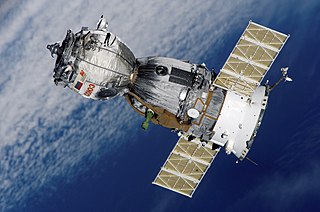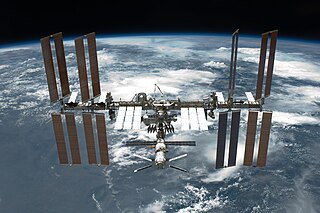See also
- Mikoyan-Gurevich MiG-105 — Soviet orbital spaceplane
- Spaceplane
- Spacecraft
| Type | Buran-class orbiter |
|---|---|
| Construction number | 5K |
| Country | Soviet Union |
| Contract award | 1983 |
| Status | Dismantled |
2.03 (GRAU index serial number 11F35 5K) is the designation of the fifth [1] Soviet/Russian Buran-class orbiter to be produced as part of the Buran programme. It was never officially named.
2.03 was a second series shuttle orbiter, as shown by the '2' in its number. Construction of 2.03 was barely underway [2] when the entire Buran programme was halted in 1993, the parts of it that had been built were dismantled shortly afterwards. Nothing remained of it by 1995.

The Buran programme, also known as the "VKK Space Orbiter programme", was a Soviet and later Russian reusable spacecraft project that began in 1974 at the Central Aerohydrodynamic Institute in Moscow and was formally suspended in 1993. In addition to being the designation for the whole Soviet/Russian reusable spacecraft project, Buran was also the name given to orbiter 1K, which completed one uncrewed spaceflight in 1988 and was the only Soviet reusable spacecraft to be launched into space. The Buran-class orbiters used the expendable Energia rocket as a launch vehicle.

Energia was a 1980s super-heavy lift launch vehicle. It was designed by NPO Energia of the Soviet Union as part of the Buran program for a variety of payloads including the Buran spacecraft. Control system main developer enterprise was the Khartron NPO "Electropribor". The Energia used four strap-on boosters each powered by a four-chamber RD-170 engine burning kerosene/LOX, and a central core stage with four single-chamber RD-0120 (11D122) engines fueled by liquid hydrogen/LOX.

A spacecraft is a vehicle that is designed to fly and operate in outer space. Spacecraft are used for a variety of purposes, including communications, Earth observation, meteorology, navigation, space colonization, planetary exploration, and transportation of humans and cargo. All spacecraft except single-stage-to-orbit vehicles cannot get into space on their own, and require a launch vehicle.

Soyuz 7 was part of an October, 1969, joint mission with Soyuz 6 and Soyuz 8 that saw three Soyuz spacecraft in orbit together at the same time, carrying a total of seven cosmonauts.
Human spaceflight programs have been conducted, started, or planned by multiple countries and companies. Until the 21st century, human spaceflight programs were sponsored exclusively by governments, through either the military or civilian space agencies. With the launch of the privately funded SpaceShipOne in 2004, a new category of human spaceflight programs – commercial human spaceflight – arrived. By the end of 2022, three countries and one private company (SpaceX) had successfully launched humans to Earth orbit, and two private companies had launched humans on a suborbital trajectory.

A reusable launch vehicle has parts that can be recovered and reflown, while carrying payloads from the surface to outer space. Rocket stages are the most common launch vehicle parts aimed for reuse. Smaller parts such as rocket engines and boosters can also be reused, though reusable spacecraft may be launched on top of an expendable launch vehicle. Reusable launch vehicles do not need to make these parts for each launch, therefore reducing its launch cost significantly. However, these benefits are diminished by the cost of recovery and refurbishment.

A spaceplane is a vehicle that can fly and glide like an aircraft in Earth's atmosphere and maneuver like a spacecraft in outer space. To do so, spaceplanes must incorporate features of both aircraft and spacecraft. Orbital spaceplanes tend to be more similar to conventional spacecraft, while sub-orbital spaceplanes tend to be more similar to fixed-wing aircraft. All spaceplanes to date have been rocket-powered for takeoff and climb, but have then landed as unpowered gliders.

The Mikoyan-Gurevich MiG-105, part of the Spiral program, was a crewed test vehicle to explore low-speed handling and landing. It was a visible result of a Soviet project to create an orbital spaceplane. The MiG 105 was nicknamed "Lapot", for the shape of its nose.

The Boeing X-37, also known as the Orbital Test Vehicle (OTV), is a reusable robotic spacecraft. It is boosted into space by a launch vehicle, then re-enters Earth's atmosphere and lands as a spaceplane. The X-37 is operated by the Department of the Air Force Rapid Capabilities Office, in collaboration with United States Space Force, for orbital spaceflight missions intended to demonstrate reusable space technologies. It is a 120-percent-scaled derivative of the earlier Boeing X-40. The X-37 began as a NASA project in 1999, before being transferred to the United States Department of Defense in 2004. Until 2019, the program was managed by Air Force Space Command.

2K, often referred to as Ptichka, is the second Buran-class orbiter, produced as part of the Soviet/Russian Buran programme. Although 2K was the closest to being completed of any of the Buran-class orbiters, it was never finished. The program was officially cancelled in 1993, at which point the shuttle was 95-97% complete. The proposed official name for 2K was Burya.
2.02 is the designation of the fourth built Soviet/Russian Buran-class orbiter to be produced as part of the Buran programme.

2.01 is the designation of the third Buran-class orbiter to be produced as part of the Soviet/Russian Buran programme. Its construction was not complete when the Buran programme was cancelled, so it remains unfinished. It was never officially named, though it's often referred to as Baikal after Lake Baikal.

The Intermediate eXperimental Vehicle (IXV) is a European Space Agency (ESA) experimental suborbital re-entry vehicle. It was developed to serve as a prototype lifting body orbital return vehicle to validate the ESA's work in the field of reusable orbital return vehicles.

Buran was the first spaceplane to be produced as part of the Soviet/Russian Buran program. Buran completed one uncrewed spaceflight in 1988, and was destroyed in 2002 due to the collapse of its storage hangar. The Buran-class orbiters used the expendable Energia rocket, a class of super heavy-lift launch vehicle. Besides describing the first operational Soviet/Russian shuttle orbiter, "Buran" was also the designation for the entire Soviet/Russian spaceplane project and its flight articles, which were known as "Buran-class orbiters".

The OK-GLI, also known as Buran Analog BTS-02, was a Soviet atmospheric test vehicle of the orbital Buran spacecraft. It was constructed for the Buran programme in 1984, and was used for 25 test flights between 1985 and 1988 before being retired.

The BOR-4 flight vehicle is a scaled (1:2) prototype of the Soviet Spiral VTHL spaceplane. An uncrewed, subscale spacecraft, its purpose was to test the heatshield tiles and reinforced carbon-carbon for the Buran space shuttle, then under development.
Avatar is a concept study for a robotic single-stage reusable spaceplane capable of horizontal takeoff and landing, by India's Defence Research and Development Organisation. The mission concept is for low cost military and commercial satellite space launches.

Origins of the International Space Station covers the origins of ISS. The International Space Station programme represents a combination of three national space station projects: the Russian/Soviet Mir-2, NASA's Space Station Freedom including the Japanese Kibō laboratory, and the European Columbus space stations. Canadian robotics supplement these projects.

The LKS was a Soviet Union spaceplane project led by Vladimir Chelomey in response to the United States Space Shuttle. The LKS was smaller and cheaper than its American counterpart, but was ultimately discarded in favor of the larger Buran. Claiming that the Buran project was too big, heavy, and expensive for Russia to complete, Chelomey designed the LKS in 1979. He ordered the construction of a full-scale mock-up, as a way to further stimulate interest. The project was never fully sanctioned however, and in 1982, Chelomey was officially ordered by the Soviet government to stop any further development. In March 1983, Chelomey made yet another attempt to obtain permission to build the LKS to repel US Intercontinental ballistic missiles. This too proved futile. In 1991 the mock-up was destroyed, possibly by sabotage.